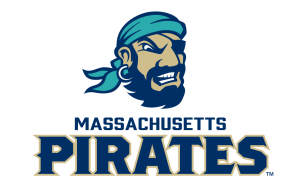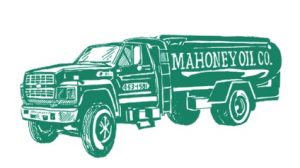
Photo Courtesy Henry Marte/Marte Media
by Dr. Anne Mulhern
In Ecumenical Plaza, in the Acre district between the St. Patrick Church and the Holy Trinity Hellenic Orthodox Church of Lowell, stand three new sculptures by local artist Jay W. Hungate. If you don’t look up, you’re bound to miss them, because these remarkable fish are mounted high atop poles, turning as the wind changes. Look more closely, and you’ll see that the fish scales are pop-top can lids, and the fish mouths are made of tin cans. Take a step back, so you can bring them all into view, and you’ll find they form a pleasing group, each fish with different colored pectoral fins.
Many Lowell residents will recognize Hungate for his regular participation in the Lowell Kinetic Sculpture Race. When the Kinetic Sculpture race debuted in Lowell in 2016, Hungate’s vehicle competed as “The Iconic Flying Fish”. It turns out that the Ecumenical Plaza fish are the artistic descendants of the original fish sculpture from “The Iconic Flying Fish” vehicle, which sculpture was recently put up for auction at the Whistler House Holiday Party and Art Auction.
I wanted to find out a bit more about these fish, so I took the direct approach of asking the artist the following questions:
- Where does the material for the ventral fins, the little triangular ones with the perforations come from?
These little fins are repurposed parts from an old vegetable steamer basket that I salvaged many years ago. I was thrilled when I realized they would work for these fish, and that I actually had enough pieces for all three of the fish.
- How did you manage to get so many can lids? You must have needed well over a hundred for those three fish.
I had originally estimated that I’d need about 120 cat food can covers per fish, so when I received the commission, I put out a plea on social media for friends with cats to please save them for me. When I started doing the actual building of the sculptures, I realized I’d need many more than that, and a friend suggested that I ask the Lowell Humane Society to save theirs as well, which they did. So many people helped to gather all of the lids (about 500), which come in different sizes and colors. Each fish has different color combinations of the lids, which adds interest, and makes each fish unique.
- You received a grant to do this work. How did that come about?
I saw that Mosaic Lowell was working to bring attention to the Acre, and was seeking qualified artists to create temporary public artworks for the area. I enjoy making public art, so I applied, and I made it through the first round of cuts. The selected artists were then paid to create proposals for specific spots, and my assigned location was Ecumenical Plaza. The selection committee then reviewed the proposals, and approved the projects that they wanted to go forward with. I was thrilled that my proposal was approved.
- Can you tell me something about how the fish are mounted on their poles? They seem to be able to swing backward and forward pretty freely.
For this project I wanted to use as many recycled materials as possible, not only to keep the cost down, but because there’s so many great materials that get thrown away. The fish pivot on repurposed bicycle wheel hubs that I received and modified from the scrap pile at the Bike Connector.
- Do you need to use a preservative to keep the fish from oxidizing, mounted as they are outside during a Massachusetts winter?
The cat food can covers are anodized aluminum, which should be durable enough to withstand the weather, and even though the steel cans are galvanized, I decided to give them an additional coat of clear paint designed for use on cars. I’ll be interested to see how the pieces handle the harsh winter weather, which was a serious consideration when I was deciding what to submit and build.
- Is there anything about fish that makes this sculpture especially appropriate for the Ecumenical Plaza location?
I spent quite a bit of time sitting in Ecumenical Plaza studying the area, looking for ideas and inspiration. The canal and the churches are such predominant features, and for me the symbolism of fish seemed appropriate for the area. I wanted them to stand out as individuals, but also move together as a group. It’s interesting to watch how they move in the wind, and how the slightest breeze can sway their movements. The solar lights that line the sides of the fish also add interest to the pieces as they swivel in the night sky.
- Do you have any plans yet for your next Kinetic Sculpture Race vehicle?
I love participating in the LKSR, and In previous years I would have started planning and building by now. It takes a great deal of time for me to design and build the machines I’ve raced, and I love the challenge of it. I’m sure I’ll be participating in the 2024 LKSR, however, I have not yet made any decisions about it.
- Can you say any more about how the fish were constructed?
When I built the original Iconic Flying Fish in 2016, the fins were made of fabric. For these new pieces, I wanted the fins to mimic the stained glass of the two churches that border Ecumenical Plaza, so I decided to use colorful acrylic sheets. To hold the top fins and the tails to the fish, I cut and polished some old aluminum pizza pans, which are riveted in place. Just as I had done with the scales, I underestimated how many rivets I’d need for the project, and I think I bought out every local hardware store’s supply of aluminum rivets by the end.
- Your Kinetic Sculpture Race fish was put up for auction at the Whistler House Holiday Party and Art Auction. How did that come about?
I’ve had the Iconic Flying Fish hanging in my studio for a while, and when I saw that the Whistler House Museum of Art was having a show of animal related artworks for their exhibition “All Creatures Great and Small”, I decided to update the fish and submit it to be exhibited. I wasn’t sure it would be accepted, since it’s not a traditional form of sculpture, but they accepted it, and then when the museum sought artwork for their annual holiday fundraiser, I decided it would be a good idea to offer it with the stipulation that half the proceeds should go to the Lowell Humane Society. Sara Bogosian, the Director of the Whistler House Museum of Art agreed, and the sculpture was put up for auction. I’m thrilled that at the end of the exhibition the sculpture will go to a wonderful home in Lowell, and that the sale of the artwork has supported two great Lowell institutions.
Well now that I’ve learned all that I’ll be heading back to Ecumenical Plaza, monocular in hand to get an even better view of these remarkable flying fish.
Look for more aquatic public artwork from Hungate next year: the Waterdragon, formerly at the National Parks Visitor Center, will return in glorious iridescence, with recycled DVDs and CDs for its scales, to a Wannalancit Mills location.













One response to “Local Artist Blows “Lid” Off Ecumenical Plaza”
Thanks for the great article about a great artist and his wo derful art